Define electric dipole and find an expression for the electric potential at a point on the axis of an electric dipole.

Understand the Problem
The question asks for the definition of an electric dipole and to find an expression for the electric potential at a point on the axis of an electric dipole. This requires knowledge of electrostatics and the properties of electric dipoles.
Answer
An electric dipole is a pair of equal and opposite charges separated by a distance. The electric potential on its axis is V = (1 / 4πε₀) (p / r²).
An electric dipole consists of two equal and opposite charges, +q and -q, separated by a small distance 'd'. The electric potential (V) at a point on the axis of an electric dipole is given by V = (1 / 4πε₀) (p / r²), where p is the dipole moment (p = qd), r is the distance from the center of the dipole to the point, and ε₀ is the permittivity of free space.
Answer for screen readers
An electric dipole consists of two equal and opposite charges, +q and -q, separated by a small distance 'd'. The electric potential (V) at a point on the axis of an electric dipole is given by V = (1 / 4πε₀) (p / r²), where p is the dipole moment (p = qd), r is the distance from the center of the dipole to the point, and ε₀ is the permittivity of free space.
More Information
The electric potential due to a dipole decreases more rapidly with distance (1/r²) than that of a single charge (1/r).
Tips
Make sure to define all variables in the final expression.
Sources
- Electric potential (V) at a point due to an electric dipole - geeksforgeeks.org
- Electric potential due to a point charge q - byjus.com
- Electric Field Of A Dipole - byjus.com
AI-generated content may contain errors. Please verify critical information